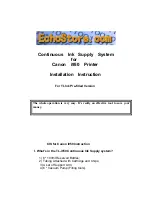
Page
9
EQ2-UM-1.3
Definitions
Soil Matric Potential
Studies of plant growth need to characterise the
availability
of water to the plant, and this
is usually done using the water potential,
Ψ
, which measures the suction necessary to
extract water from the soil, and has units of pressure, kPa. Components of this water
potential are contributed by gravity, atmospheric pressure, osmosis, and the capillary
action of the soil particles. This last component, called the Soil Matric Potential,
Ψ
M
, is
highly dependent on the wetness of the soil, and varies from 0 kPa at field capacity, down
to approximately -1500 kPa at the permanent wilting point.
Soil Water Content
versus
Soil Matric Potential
The relationship between soil matric potential and soil water content is called the
soil
water release curve
(it seems to have about 5 other names as well). It differs
enormously form one soil to another, particularly from clay soils at one extreme to sandy
soils at the other. There is no generalised method of converting from soil water content to
matric potential, though a number of expressions have been found which have been
successfully applied to a restricted list of soil types, see for example references 2.
References
1.
Gaskin, G.J., and J.D. Miller. 1996. Measurement of soil water content using a
simplified impedance measuring technique. J. agric. Engng Res. 63: 153-160
2.
Campbell, G.S. 1974. A simple method for determining unsaturated conductivity
from moisture retention data. Soil Sci. 117:311-314






























